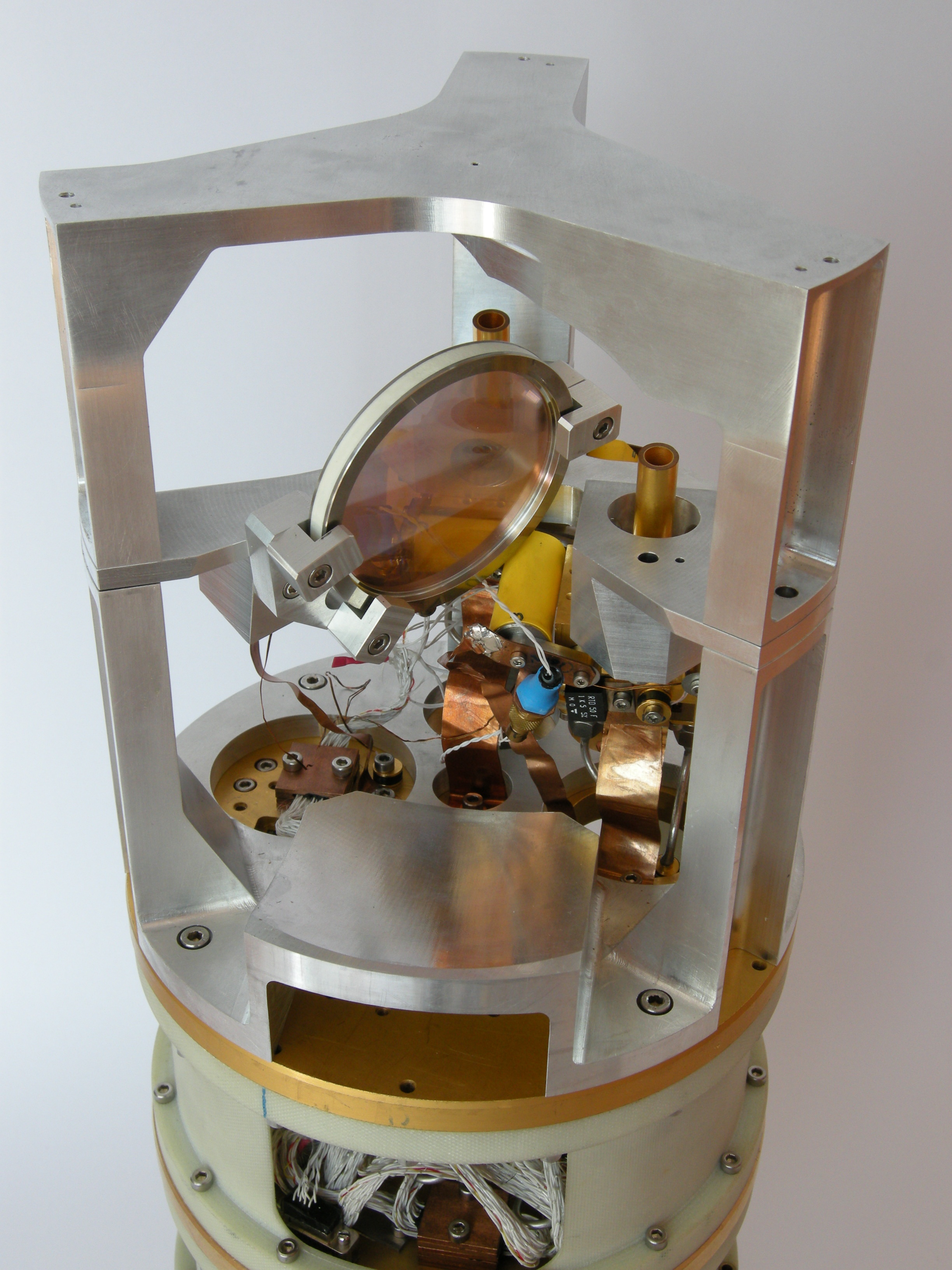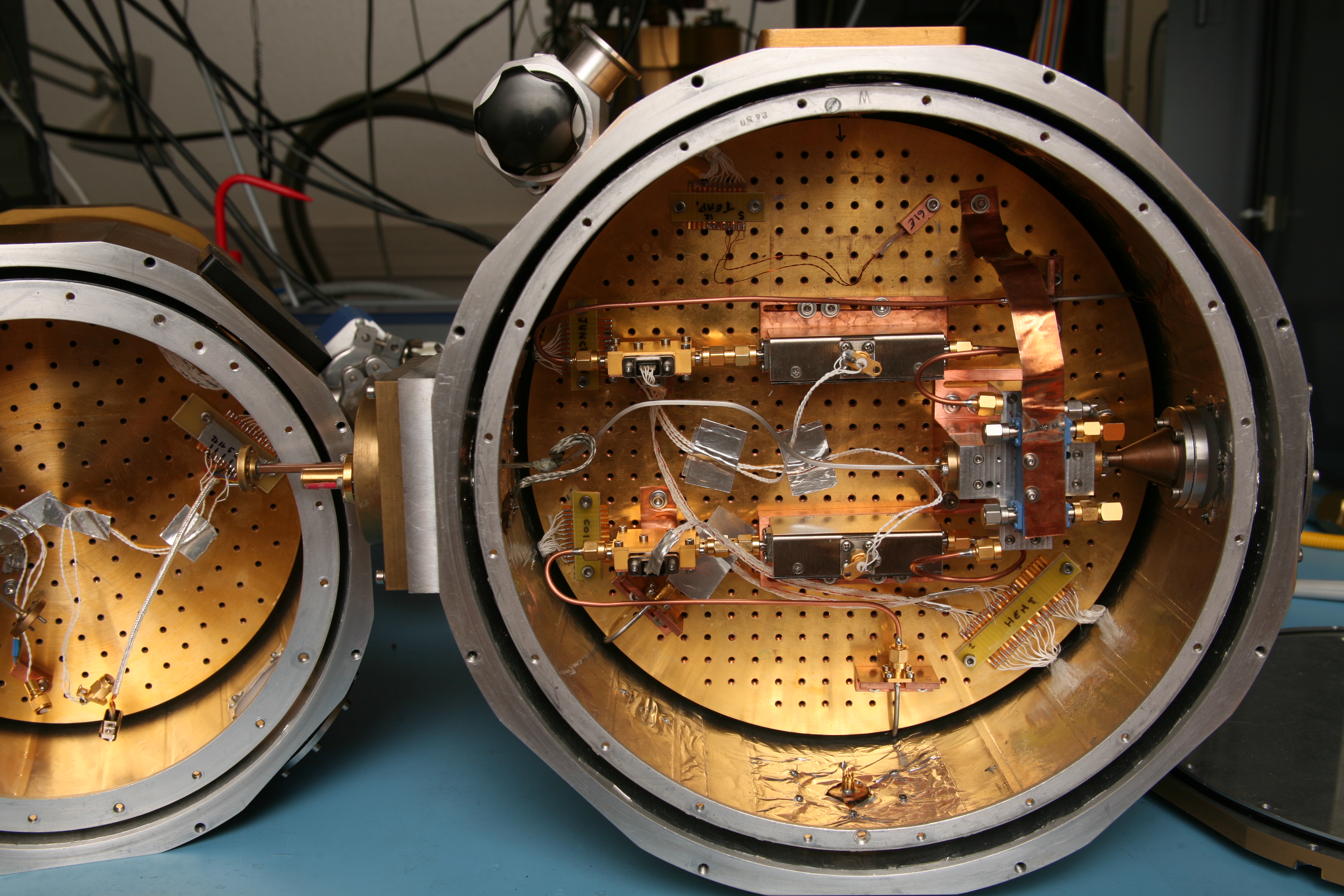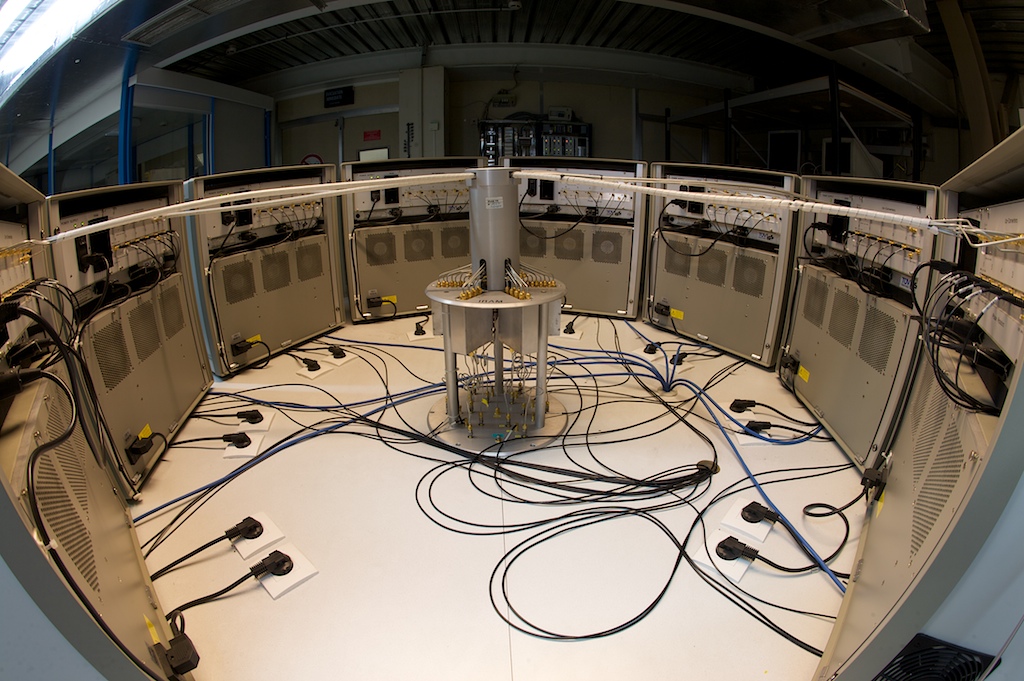The signal path
When they reach the surface of an antenna, signals from cosmic sources are extremely weak. Their weakness is such that the IRAM 30-metre telescope would have to collect them during a period spanning the entire age of the universe (13.7 billion years) to obtain enough energy to power a light bulb for one second.
The signals have thus to be amplified before they can be analysed: this is the role of the receiver. However, it is technically very difficult, if not impossible, to directly amplify signals emitted at short wavelengths (or high frequencies) such as in the millimetre range. Therefore, the frequency of the incoming signal is first lowered into the mixer block of the receiver, a device only a few centimetres in size, and only then amplified.
 Once the signals are collected by the antenna, they are focused onto the receiver, where they reach the horn and are channelled through a narrow, millimetre-sized conduit called the wave-guide, before reaching the mixer itself.
Once the signals are collected by the antenna, they are focused onto the receiver, where they reach the horn and are channelled through a narrow, millimetre-sized conduit called the wave-guide, before reaching the mixer itself.
Inside the mixer, the signals are combined in the coupler to a signal with a close-by frequency that is produced by the local oscillator. The super-conducting junction registers the difference between these two signals, the intermediate frequency, one low enough that the signal can finally be amplified.
The mixer is also equipped with super-conducting circuits in order to separate the two incoming signals and to optimise the super-conducting junction’s performances.
This entire process has been conceived and developed by IRAM engineers, technicians and scientists. Using micro-mechanical manufacturing technologies, the horn, coupler and mixer are designed and manufactured at the institute’s mechanical workshop and assembled in its laboratories.
With a size of less than one micrometer (a thousandth of a millimetre), the super-conducting junction is the core piece of the receiver system, ensuring the transmission of the astronomical signal with as little background noise as possible.
The junction consists of two niobium metal layers, a metal which near absolute zero becomes super-conducting, without resistance and thus without any additional background noise. This is why specially built cryostats, which are cooled by helium, maintain the receivers at a constant temperature of -269C°. The two super-conducting layers are themselves separated by a thin insulating layer of aluminium oxide, one nanometre in size (a thousand of a thousand of millimetre).
 The cosmic signal triggers electric charges between the two metal layers of the junction. This process, called the photon tunnel effect, is the actual receiving process in a millimetre system, in other words, collecting and registering of the photons of incoming cosmic signals. IRAM operates its own laboratory for the development and fabrication of super-conducting junctions, employing modern coating processes under ultra-high vacuum conditions as well as micro-lithographic methods in order to structure the junctions.
The cosmic signal triggers electric charges between the two metal layers of the junction. This process, called the photon tunnel effect, is the actual receiving process in a millimetre system, in other words, collecting and registering of the photons of incoming cosmic signals. IRAM operates its own laboratory for the development and fabrication of super-conducting junctions, employing modern coating processes under ultra-high vacuum conditions as well as micro-lithographic methods in order to structure the junctions.
With its long-time expertise, IRAM is able to build receiver systems, which guarantee a perfect signal transmission, only affected by unavoidable quantum noise. Leader in the field of high frequency technologies, IRAM also develops receiver systems for the ALMA observatory in the Southern Hemisphere.
IRAM's Digital Universe
Located in the main building of the observatory, the correlator plays a key role in collecting signals coming from the antennae, in particular in interferometry.
With a processing power of thousands of billions of operations per second, the correlator is able to filter out the smallest signal from the background noise generated by quantum effects and the environment. Unlike these random noises, the cosmic signal usually does not vary. The correlator averages the incoming signal over time, so that noise diminishes and the cosmic signal gradually appears. Simultaneously, the correlator compensates for the signals’ delays caused by the earth's rotation.
All the electronic circuits required for these operations – including a large number of specific silicon chips – are designed and manufactured for this purpose.
 By analyzing and classifying thousands of incoming frequencies, the correlator enables astronomers to identify molecules. Using the temporal delay of the signals reaching the antennae, it also provides necessary information about the sources' positions on the sky. This is why a special electronic device continuously measures to an accuracy of a millimetre the cables’ length between the antennae and the main building.
By analyzing and classifying thousands of incoming frequencies, the correlator enables astronomers to identify molecules. Using the temporal delay of the signals reaching the antennae, it also provides necessary information about the sources' positions on the sky. This is why a special electronic device continuously measures to an accuracy of a millimetre the cables’ length between the antennae and the main building.
To optimize both signal and data transmission, the Plateau de Bure is covered with an underground network of single-mode optical fiber and cables.
Contrary to the NOEMA interferometer, the 30-metre telescope has no correlator, but several spectrometers working on the principles of auto-correlation and using analogue filtering and Fourier transformations.
The bandwidths used in the millimetre domain are several hundred times larger than those used for the fastest Internet connections to date.
The stream of data delivered by the correlator is subsequently processed by specific software that was developed at IRAM. The institute has become one of the world-leaders for the design and development of software in millimetre radio astronomy.
Several control programs – including antenna steering as well as receiver and backend tuning – have been created by engineers and astronomers from IRAM, as well as software for observation management, data reduction and archiving. IRAM has also pioneered dynamic scheduling of astronomic observations. These programs are regularly updated and adapted to scientific needs. The data reduction software of IRAM is freely accessible and currently used by many radio observatories worldwide.
This active technical research and development is at the core of the cutting edge instrumentation available at the IRAM telescopes. It also impacts other fields such as medical imaging, high-speed communication technology, precision remote sensing and atmospheric research.

